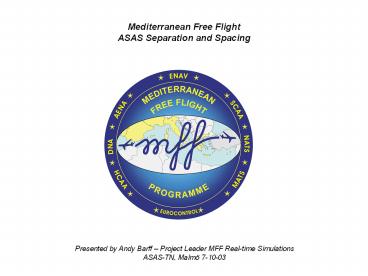Mediterranean Free Flight ASAS Separation and Spacing - PowerPoint PPT Presentation
Title:
Mediterranean Free Flight ASAS Separation and Spacing
Description:
ASAS-TN, Malm 7-10-03. This presentation explains 2 aspects of MFF: ... 'AFR123 squawk ident' - 'AFR123 re-identified, back under positive radar control' ... – PowerPoint PPT presentation
Number of Views:30
Avg rating:3.0/5.0
Title: Mediterranean Free Flight ASAS Separation and Spacing
1
Mediterranean Free FlightASAS Separation and
Spacing
Presented by Andy Barff Project Leader MFF
Real-time Simulations ASAS-TN, Malmö 7-10-03
2
- This presentation explains 2 aspects of MFF
- ASAS Separation Applications and Simulation
Design - ASAS Spacing An Integrated Approach
3
ASAS Separation
4
MFF ASAS Separation Concept
- Definition in line with PO-ASAS
- Delegation of separation responsibility to the
flight crew for a particular manoeuvre in
relation to a target aircraft limited in space
and time - Applications
- Crossing Procedures
- Lateral Crossing (pass behind)
- Vertical Crossing (pass above or below)
- Overtaking Procedures
- Lateral overtaking (pass to the right or left)
- In-trail Procedures
- Remain in trail
- Merge in trail
- In-trail climb or descent
- In-trail climb or descent to same level
5
MFF ASAS Separation Simulation
- Simulation of Greek and Maltese airspace
- October 20th 31st 2003
- 4 days training
- 1 day of reference exercises
- 5 days of ASAS evaluation
- 2 large sectors over central Mediterranean
(mainly high seas) - Simulation of radar and ADS-B surveillance
- An area of poor or no surveillance
- Inter-centre transfer procedures
- Experimental Design
- Qualitative assessment of ASAS Separation
applications - Traffic samples tuned to offer several ASAS
opportunities every 6-10mins - Current fixed route structure and existing sector
dimensions - Technical Features
- Position symbol reflects surveillance quality
- ADS-B down-linked parameters displayed on demand
in track label
6
MFF RTS3 Greece-Malta Scenario
? AFR123 350 350 350 g45 hdg m.84 rocd
? BAW456 350 350 350 g45 h270 m.82 r0
7
(No Transcript)
8
(No Transcript)
9
ASAS Spacing An Integrated Approach
10
ASAS Spacing as a System Component
- ASAS Spacing cannot be considered in isolation
- Unlike RVSM for example.
- It seems that the benefits of ASAS Spacing will
be greatest when it is a component of an
integrated concept of operations - Current practices will have to evolve to include
ASAS Spacing in the more efficient management of
arrival flows probably including RNAV arrival
procedures - Current practices (generally) include
- Extensive marshalling and vectoring at low
altitudes - Some use of holding (ready supply of a/c to
maximise runway capacity) - This is not really compatible with the extensive
use of ASAS Spacing because spacing set up in the
ETMA will be lost if there is holding or
extensive vectoring - New tasks for en-route sectors establishing the
sequence in the vicinity of top of descent
11
Towards a more efficient arrival flow
12
ASAS Spacing as a System Component
- MFF is initiating a study of Rome arrivals using
ASAS Spacing as a tool in a more efficient
arrival concept.. - Subtle sector revisions to allow the controllers
to concentrate on the management of arrivals.
Overflights and outbounds handled mainly by other
sectors - Key objectives
- To ensure that the en-route/ETMA sectors can
effectively establish the arrival sequence before
or shortly after Top of Descent - To study the feasibility of merging of ASAS
spaced flows at medium level - To study the impact on the TMA sectors in terms
of holding (reduction), environmental/efficient
trajectories (mileage/levels) and controller
workload/concept feasibility
13
MFF RTS3 Rome Scenario































